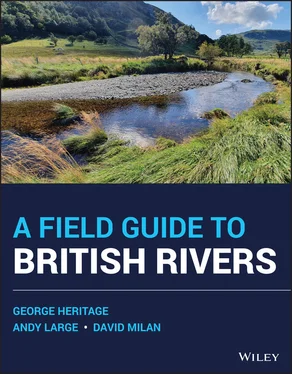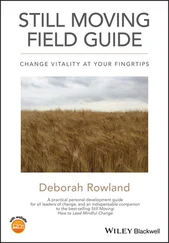It is interesting to reflect on the reasons behind the present degraded state of temperate rivers and the common acceptance that this current state is “how a river should be.” Significant, almost wholesale, channel and floodplain modification occurred throughout the agricultural and industrial revolution as valley bottomlands were exploited for food production and industrialists sought to utilise the power of rivers for energy for manufacturing activities. River channels were moved, straightened, embanked, and deepened, and the new channels had their banks protected with wood and stone. While large extents of natural wooded vegetation was removed as part of this activity, trees (but, more often than not, monoculture) were planted along bank margins to prevent them moving from their designated route. Floodplains and later uplands were drained to improve land for crops and grazing and urban rivers were completely channelised to prevent flooding. Generations have now grown up with these modified rivers, and as a result, we have now accepted that they are somehow “natural.” Our own limited experience of rivers has led to the widespread belief that rivers are liquid ribbons in the landscape; static systems, immovable in the landscape and not part of the surrounding floodplain fields and meadows. We talk of rivers “bursting their banks” – a negative term implying that overspilling to occupy the floodplain temporarily is somehow unnatural. Increasingly, as management of temperate rivers reduces on the part of national agencies, requests are made to “fix” rivers by “repairing” banks, dredging sediment, and removing wood and other vegetation to recreate the “neat” channels people remember from days gone by. Such perceptions are not aided by the current teaching of river science in schools. Geography and environmental lessons in schools perpetuate outdated concepts; for example, textbooks concentrate on meandering systems and pool‐riffle sequences and decades old river typologies that, despite rivers being continua, divide catchments into upper, mid‐reach and lowland meandering sections – ignoring the irony that the latter are rarely permitted to be mobile nowadays.
All these modifications have not just altered the physical form of temperate rivers and valley bottoms, they have also fundamentally impacted on the flow regime and the way in which river systems erode, transport and store sediment. As such, we are left with systems that are a neutered shadow of their former selves, where both natural processes and natural form are severely impacted resulting in a highly degraded river channel and valley bottom. The simple single‐thread channel, often featureless and constrained, dominates our riverine landscapes with many other river types now all but extinct. Many rivers also now experience more extreme flows across the year, with winter flood extremes testing flood defences to their limits and spring and summer low flows that border on drought conditions. Whilst both extremes may have their origins in climate change, there is no doubt that they have been exacerbated by inappropriate upland drainage management impacting on the flow paths and speed of water once it has hit the ground.
Such a situation should not be allowed to continue and fortunately several factors are presently operating that provide encouragement that more natural river and floodplain systems can make a resurgence. The first is the current reluctance amongst statutory bodies to continue with the intensive management of watercourses due to their routine maintenance budgets being significantly reduced from those of a decade or two ago. This is giving many rivers a chance to begin to erode and deposit sediment once again; however, channel response in often highly localised and more extreme than would occur naturally as failing protection creates “hotspots of change.” Alongside this, there is an increasing recognition that impacted flood regimes require addressing at source rather than just at flooding hotspots, and Natural Flood Management approaches to slow flood flows and store flood water are gaining traction in terms of catchment‐oriented efforts to restore river and floodplain connectivity and channel dynamism. More recently, it has been recognised that degraded sediment transport regimes are also influencing the potential for flooding with heightened levels of gravels accumulating in urban areas because of disconnected storage in the catchment and altered sediment transport efficiencies in upstream rivers. Natural Sediment Management where sediment storage zones are reconnected and channel form naturalised to a more storage friendly configuration can help reduce flood sediment inputs to vulnerable areas whilst restoring natural form and processes to the fluvial system upstream. Finally, the trend amongst owners of large estates to re‐wild the landscape and reintroduce extinct species is also improving larger and larger areas, often with valley bottom land being encouraged to naturalise through light touch interventions that act as the precursor for wider river‐driven landscape change. The recent efforts to reintroduce ecosystem engineers such as beaver also points to greater willingness in UK river managers to turn back the clock and allow greater space for nature.
The natural environment is now rising in value with an increasing recognition of the role that natural system dynamics can play in climate change, biodiversity, as well as amenity, and there appears to be a growing political will in the United Kingdom to instigate change, with new government stewardship schemes likely to place a very strong emphasis on environmental functionality, helping push the river restoration agenda forward. In all cases, this can only be achieved successfully with the appropriate knowledge. During the time we have been writing this book, Britain has left the European Union, and so it remains to be seen what trajectory environmental protection will take post departure, but initial statements from government indicate a willingness to legislate for more protection, not less. What is key is that any range of protection methods should ensure a place for enhanced dynamism, not less.
Future sustainable management of our rivers and floodplains therefore requires a fuller understanding of river form and function to ensure that opportunities are fully exploited, and our perception of rivers is changed towards more naturally functioning dynamic systems. We have written this book deliberately as a field guide to maximise the practical examples of river types and to highlight the pressures they experience and their often parlous condition. This book is intended to better inform both river management approaches and policy necessary to achieve this. It will hopefully stimulate a desire to bring back the diversity and dynamism associated with naturally functioning temperate fluvial systems in the United Kingdom. The ethos of the book is to inspire the river scientists in us all, by providing a holistic picture of the variety of temperate river forms in Britain and linking this explicitly to functional controls within the catchment. Fundamentally, we seek to demonstrate and evidence how the hydrological, geomorphological, and ecological functions of rivers integrate to generate and maintain the dynamic whole. If those who have read this book find themselves questioning what they see each time they encounter a river and its floodplain, this volume will have served its purpose.
George Heritage
Andy Large
David Milan
July 2021
1 British Rivers: Status and Condition
1.1 Introduction
Rivers in the United Kingdom are an important component of the natural and social environment. Humans have long influenced valley bottom ecosystems, with impacts recorded consistently across Europe since the Bronze Age (Brown et al. 2018). Through the historic period, there has been a near‐consistent alteration of system character and functionality with ecosystem dynamics suppressed to facilitate human exploitation of watercourses and valley bottoms. Landscape‐scale disturbance across regimes that sustain habitats and biotic communities have resulted in a permanent loss of environmental heterogeneity and biodiversity (Warren and Liss 1980).
Читать дальше












